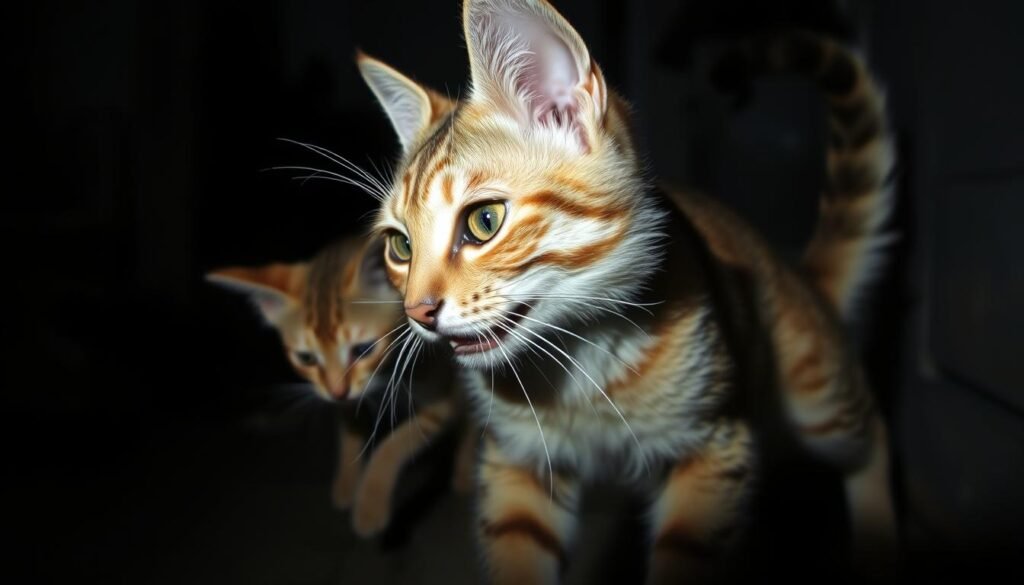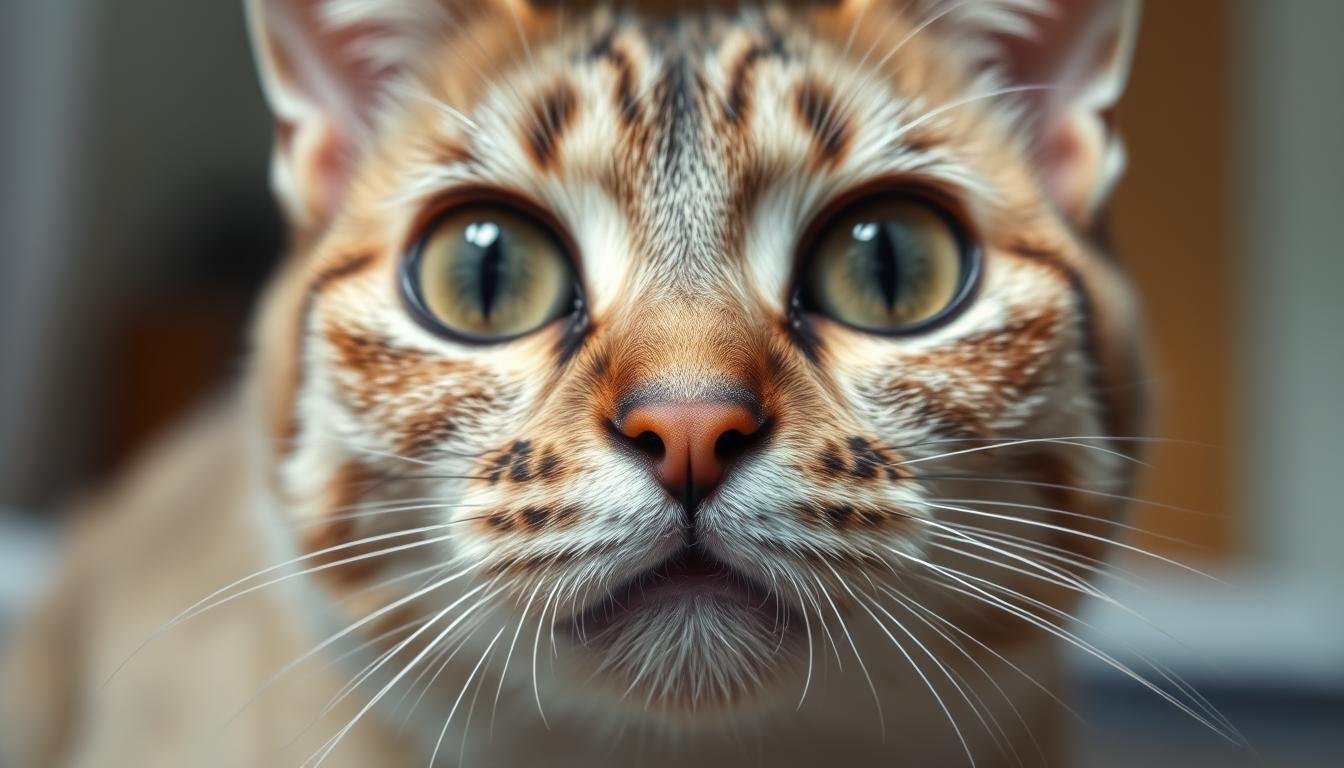Warning Signs of Cats With Rabies Behavior You Shouldn’t Ignore
Table of Contents
As a cat owner, you want to keep your pet healthy and safe. But, there’s a big feline health concern you might not think about: rabies. This disease is not just for dogs; it can hit any mammal, including cats.
In the U.S., it’s surprising that rabies hits more cats than dogs. This shows how vital it is to know the risks and spot behavioral changes in cats with rabies. Being informed helps you protect your pet and family.
What is Rabies and Why It’s Dangerous for Cats
Cats can get rabies, a deadly virus. It attacks the brain and can be fatal if not treated. Knowing the risks and symptoms is key to keeping your cat safe.
The Rabies Virus Explained
The rabies virus is a deadly pathogen that harms the brain and spinal cord. It spreads through bites, entering the body through infected animal saliva. Once inside, it travels to the brain, causing inflammation and damage.
How Rabies Affects the Feline Nervous System
Rabies damages the brain and spinal cord in cats. This leads to symptoms like changes in behavior and paralysis. The virus disrupts normal nervous system function, causing severe symptoms.
Knowing how rabies affects cats is crucial for early detection and prevention. By understanding the risks and taking precautions, you can protect your cat from this dangerous disease.
How Cats Contract Rabies
Cats usually get rabies from bites by infected wild animals. Raccoons, skunks, bats, and foxes often carry the virus. If a cat meets one of these animals and isn’t vaccinated, the risk of getting rabies is high.
Common Transmission Methods
Rabies spreads mainly through infected animals’ saliva, usually from a bite. It can also spread if the saliva touches an open wound or mucous membranes. It’s essential to keep your cat’s vaccinations up to date to prevent the disease.
- Bites from infected animals
- Contact with infected saliva through open wounds or mucous membranes
High-Risk Scenarios for Indoor and Outdoor Cats
Outdoor cats face more danger because they meet wild animals more often. But indoor cats aren’t completely safe either. If an infected animal gets into your home, your indoor cat could get sick. Keeping your cat indoors can reduce but not eliminate the risk. It’s important to vaccinate your cat, whether they stay inside or outside.
The Progression of Rabies Infection in Cats
Rabies in cats starts with an incubation period and then goes through different stages. Knowing these stages helps spot the disease early.
Incubation Period Variables
The time it takes for rabies to show in cats varies a lot. It can be from a few days to months or even years. The severity of the bite, where the wound is, and how much virus is spread all play a part.
The Three Clinical Stages of Rabies
Rabies in cats goes through three main stages: prodromal, excitative (furious), and paralytic (dumb).
Prodromal Stage
The prodromal stage shows small changes in behavior. Cats might be more affectionate or irritable. They might also change how they sound. This stage usually lasts 2 to 3 days.
Excitative (Furious) Stage
The excitative or furious stage comes next. Cats often become aggressive, biting and attacking without reason. This is when you see “rabies cat aggression.”
Paralytic (Dumb) Stage
The last stage, the paralytic or dumb stage, is when cats start to lose muscle control. It starts with the face and spreads to the whole body. This leads to coma and death.
| Stage | Characteristics | Duration |
|---|---|---|
| Prodromal | Behavioral changes, increased affection or irritability | 2-3 days |
| Excitative (Furious) | Aggressive behavior, biting, attacking | Variable |
| Paralytic (Dumb) | Paralysis, coma, death | Variable |
“Rabies is a fatal viral disease that affects the nervous system of mammals, including cats. It’s primarily spread through the saliva of infected animals, usually through a bite.”
Knowing these stages and their signs can help spot rabies in cats early. But, once symptoms show, the disease is always fatal. The best way to prevent it is through vaccination.
Cats with Rabies Behavior: Key Warning Signs
It’s important to spot the early signs of rabies in your cat. Rabies is a deadly virus that harms the nervous system of mammals, including cats. The first sign is often a bite from another infected animal. If your cat is bitten by another pet, talk to the owner about rabies risks.
Early Behavioral Changes to Watch For
Behavioral changes in your cat can signal rabies. These signs can be small, so watch your pet closely.
Changes in Vocalization
Cats with rabies may make unusual sounds. They might hiss, growl, or meow more than usual. This is because the virus affects their nervous system, changing their voice.
Altered Eating and Drinking Habits
Rabid cats may change how they eat and drink. They might not want to eat or drink, or they might eat things they shouldn’t. This is a warning sign that needs attention.
Physical Symptoms in Initial Stages
Look out for physical signs too. These include drooling, being very tired, or trouble swallowing. Seeing these signs means you should get vet help right away.

Knowing these early signs can help you spot rabies in your cat. If you think your cat has rabies or shows symptoms, see a vet fast.
Advanced Behavioral Symptoms of Rabid Cats
Cats with rabies may show many signs, from being very aggressive to being unable to move. It’s important to know these signs early to protect everyone.
Aggressive Behaviors in the Furious Form
Rabid cats can become very aggressive. They might attack people or other animals without reason. This is the furious form of rabies.
Unprovoked Attacks
One scary sign is when they attack without warning. This makes it very dangerous to be near them.
Excessive Salivation and Biting
The virus also makes them salivate a lot and want to bite more. This is very risky because it can spread the disease.
“Rabies can cause cats to become aggressive and bite without provocation, making it a significant public health concern.”
Withdrawn Behaviors in the Paralytic Form
Some rabid cats act differently. They become very quiet and withdrawn. This is the paralytic form of rabies.
Difficulty Swallowing
They might have trouble swallowing because their throat muscles are paralyzed. This is because the virus affects their nervous system.
Progressive Paralysis Signs
As it gets worse, they may start to lose control of their body. This starts with their face and goes down to the rest of their body. Eventually, they may fall into a coma and die.
It’s very important to recognize these signs early. If you think your cat has rabies, call animal control or a doctor right away.
Distinguishing Rabies from Other Feline Conditions
Identifying rabies can be tricky because it looks like other feline diseases. This makes it important to get a correct diagnosis. Symptoms of rabies can be mistaken for other conditions.
Conditions That Mimic Rabies Symptoms
Several feline conditions can show symptoms like rabies. These include tetanus, meningitis, and toxoplasmosis. They can cause similar signs like neurological problems, aggression, and changes in behavior. This makes it hard to tell them apart.
| Condition | Similar Symptoms to Rabies |
|---|---|
| Tetanus | Muscle stiffness, rigidity |
| Meningitis | Aggression, neurological signs |
| Toxoplasmosis | Behavioral changes, neurological symptoms |
Behavioral Differences Between Rabies and Common Illnesses
Rabies causes big changes in behavior, but other illnesses can act similarly. For example, a cat with hyperthyroidism might be irritable. But a cat with rabies could be very aggressive without reason. Knowing these differences is crucial for the right diagnosis.

Diagnosing Suspected Rabies in Cats
Diagnosing rabies is hard because there’s no live test. If you think your cat might have rabies, knowing what to do next is key.
Why Live Testing Isn’t Possible
There’s no sure way to test for rabies in cats that are alive. If you think your cat was exposed, your vet will tell you to keep it separate and watch for signs. This is because it’s hard to find the rabies virus in living animals.
Post-Mortem Diagnostic Procedures
To really know if a cat has rabies, you need to test its brain after it dies. The most used test is the Direct Fluorescent Antibody (DFA) test. This test stains brain samples to see if the rabies virus is there.
| Diagnostic Method | Description | Timing |
|---|---|---|
| Direct Fluorescent Antibody (DFA) Test | Detects rabies virus in brain tissue | Post-mortem |
| Isolation and Observation | Monitoring for symptoms after suspected exposure | Post-exposure |
Knowing how to diagnose rabies is important for rabies cat care and feline health concerns. If you think your cat has rabies, talking to a vet is the first step. They can help figure out what to do next and keep people safe.
Human Health Risks and Safety Precautions
Rabies is a serious threat to human health, especially for those close to infected cats. If you notice aggressive cat behavior or rabies cat aggression, be cautious. It’s important to know the risks and take steps to stay safe.
When facing a cat that might be sick, your safety comes first. The first thing to do is stay away from the cat. If you get bitten or exposed, get medical help right away.
Immediate Steps After Potential Exposure
If you’ve been bitten or exposed to a possibly rabid cat, here’s what to do:
- Wash the wound well with soap and water.
- Get medical help fast.
- Tell local animal control or the police about it.
Acting quickly can greatly lower your risk of getting rabies.
Post-Exposure Prophylaxis Protocol
Post-exposure prophylaxis (PEP) is key to stopping rabies after exposure. PEP includes:
- Washing the wound right away.
- Getting rabies immune globulin.
- Getting a series of rabies shots.
It’s crucial to follow the full PEP plan as your doctor tells you to make it work.
If you think you’ve been exposed to rabies, call your doctor right away. You might need rabies vaccines to keep the infection from spreading.
Preventing Rabies in Your Feline Companion
Keeping your cat safe from rabies is very important. It’s good for their health and keeps you safe too. To prevent rabies, make sure your cat gets their shots on time. Also, keep their living area safe to avoid risks.
Vaccination Schedules and Requirements
Getting your cat vaccinated is the best way to protect them from rabies. Talk to your vet to find out the right rabies vaccination schedule for your cat. This depends on their age, health, and local laws.
A typical rabies vaccination schedule for cats includes an initial shot and boosters later. These boosters are needed every one to three years. This depends on the vaccine and local rules.
| Vaccination Stage | Age/Interval | Vaccine Type |
|---|---|---|
| Initial Vaccination | Typically at 12-16 weeks | Killed Virus |
| First Booster | 1 year after initial | Killed Virus |
| Subsequent Boosters | Every 1-3 years | Killed Virus or Recombinant |
Environmental Management for Prevention
Managing your cat’s environment is also key to preventing rabies. This means keeping them away from animals that might carry rabies, like stray cats and raccoons.
One of the best ways to keep your cat safe is to keep them indoors. If they do go outside, watch them closely. Make sure they don’t meet wild animals.
Conclusion: The Critical Importance of Rabies Awareness
Rabies is a deadly disease that can harm any mammal, including cats. It’s important to know how cats act when they have rabies and the signs of the disease. This knowledge helps in catching it early and stopping it from spreading.
Knowing the risks and taking steps to avoid them can protect your pets and you. Getting your cat vaccinated is a big step in preventing rabies. Also, regular vet visits are key to keeping your cat healthy and safe.
As a cat owner, it’s your duty to know about rabies and how to prevent it. By being proactive, you can help keep your family and pets safe. This also helps in keeping your community free from this dangerous disease.

